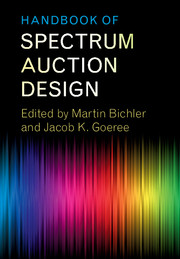Book contents
- Frontmatter
- Contents
- List of Contributors
- Preface
- List of Papers
- Part I The Simultaneous Multiple-Round Auction
- Part II The Combinatorial Clock Auction Designs
- Part III Alternative Auction Designs
- 18 A Combinatorial Auction Mechanism for Airport Time Slot Allocation
- 19 A New and Improved Design for Multi-Object Iterative Auctions
- 20 Hierarchical Package Bidding: A Paper & Pencil Combinatorial Auction
- 21 Assignment Messages and Exchanges
- 22 The Product-Mix Auction: A New Auction Design for Differentiated Goods
- 23 The Continuous Combinatorial Auction Architecture
- 24 Coalition-based Pricing in Ascending Combinatorial Auctions
- Part IV Experimental Comparisons of Auction Designs
- Part V The Bidders’ Perspective
- Part VI Secondary Markets and Exchanges
- Outlook
- References
23 - The Continuous Combinatorial Auction Architecture
from Part III - Alternative Auction Designs
Published online by Cambridge University Press: 26 October 2017
- Frontmatter
- Contents
- List of Contributors
- Preface
- List of Papers
- Part I The Simultaneous Multiple-Round Auction
- Part II The Combinatorial Clock Auction Designs
- Part III Alternative Auction Designs
- 18 A Combinatorial Auction Mechanism for Airport Time Slot Allocation
- 19 A New and Improved Design for Multi-Object Iterative Auctions
- 20 Hierarchical Package Bidding: A Paper & Pencil Combinatorial Auction
- 21 Assignment Messages and Exchanges
- 22 The Product-Mix Auction: A New Auction Design for Differentiated Goods
- 23 The Continuous Combinatorial Auction Architecture
- 24 Coalition-based Pricing in Ascending Combinatorial Auctions
- Part IV Experimental Comparisons of Auction Designs
- Part V The Bidders’ Perspective
- Part VI Secondary Markets and Exchanges
- Outlook
- References
Summary
Introduction and Background
The history of the continuous combinatorial auction marks the evolution of the mechanism. The concept of a combinatorial auction is due to Rassenti, Smith, and Bulfin (1982) who were motivated by the use of simultaneous ascending price auctions to allocate landing rights (Grether, Isaac, and Plott (1979 and subsequently published in 1989)). The ideas were generalized by Banks, Ledyard, and Porter (1989) to include the concept of a “standby queue” which serves a function similar to non-winning bids in the current system.
The first example of a continuous combinatorial auction is found at Brewer and Plott (1996). They demonstrate that representations in terms of binary confects of packages afford both the flexibility for widespread application and the computational speed required to support the auction. This early mechanism depended heavily on the existence of a fixed set of packages on which bids could be placed. The computer could quickly compute non-intersecting packages that maximized the value of the sale and permitted the auction to proceed as a type of continuous, simultaneous, ascending price auction. The packages played the role of items on which bids were placed. The nonintersecting packages that produced the most revenue from the auction were declared the leading bids at each instant of time. That first mechanism was followed by slight generalization to a procurement problem in which the buyer organized sellers to minimize procurement cost and sellers could offer endogenous packages. The organization was a simultaneous, decreasing price auction.
In the 1990s, the FCC was considering the adoption of a combinatorial auction as a replacement for the simultaneous, rounds-based, ascending price auction that the FCC had used to auction parts of the electromagnetic spectrum. The initial research focused on a hybrid process that consisted of rounds followed by a continuous phase. (See the report of Charles R. Plott, FCC Why River Conference, May 5–7, 2000). Experiments with the hybrid revealed that, that most of the adjustment and efficiently came from the continuous phase. That discovery led to the study of combinatorial auctions that operated only in continuous time.
- Type
- Chapter
- Information
- Handbook of Spectrum Auction Design , pp. 477 - 492Publisher: Cambridge University PressPrint publication year: 2017



